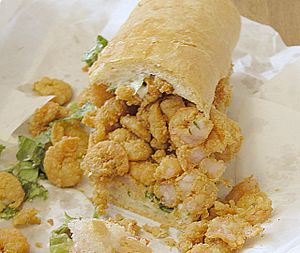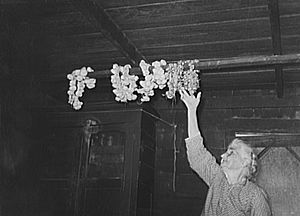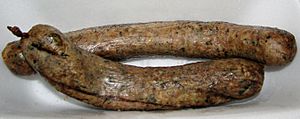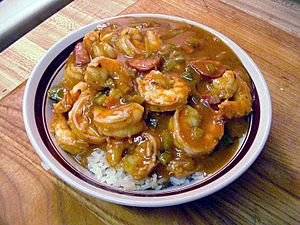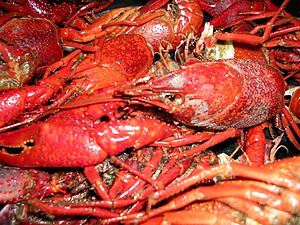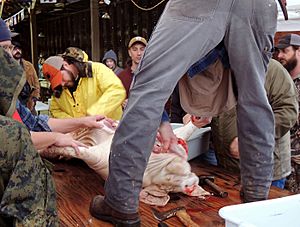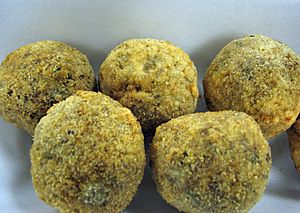Cajun cuisine facts for kids
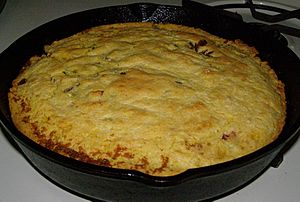
Cajun cuisine (French: Cuisine cadienne) is a special way of cooking that was created by the Cajun people. These people, also called Acadians, were forced to leave their homes in Acadia (now part of Canada) and move to Louisiana in the 1700s. When they arrived, they mixed their own cooking styles with ideas from West Africa, France, and Spain.
Cajun food is often called "rustic cuisine." This means it uses ingredients that are easy to find nearby, and the recipes are usually simple to make.
A real Cajun meal often involves three pots! One pot holds the main dish, another might have steamed rice, special sausages, or a seafood dish. The third pot usually has a vegetable that is fresh and plentiful. Some common meats you'll find in Cajun dishes are crawfish, shrimp, and a spicy sausage called andouille.
Cajun chefs often use a special mix of vegetables they call "the trinity." These are green bell pepper, onion, and celery. They chop them up and cook them together. This is similar to how French chefs use "mirepoix" (carrot, onion, and celery). For a more Creole flavor, chefs might also add parsley, bay leaf, green onions, and cayenne pepper.
Contents
History of Cajun Food
The Acadians were French settlers who lived in what is now Canada. In the mid-1700s, the British forced them to leave their homes during a war. Many of them ended up settling in Southern Louisiana.
Because the weather in Louisiana was very different, the Acadians couldn't cook their old dishes. So, they started creating new meals using local ingredients. These new dishes became what we now call classic Cajun cuisine. It's important not to confuse this traditional style with the spicier, more modern "Cajun" food made famous by chef Paul Prudhomme.
For a long time, Cajun meals were simple and not fancy. The idea that "Cajun" food is always super spicy and flavorful came from Paul Prudhomme's style, which was different from the older, more basic Cajun cooking.
Cajun and Creole cooking are often confused, but they have different beginnings. Creole cooking started in New Orleans, while Cajun cooking developed about 40 years later. Today, many restaurants serve dishes that mix both styles, which Paul Prudhomme called "Louisiana cooking." However, in homes, people often still keep the styles separate. Fewer people today cook the very old, classic Cajun dishes that the first settlers ate.
How Cajun Food is Cooked
Cajun cooking uses many different methods. Here are some common ones:
- Barbecuing: This is like slow Southern barbecue, but with Cajun spices.
- Baking: Cooking with dry heat in an oven.
- Grilling: Cooking with direct heat on a hot surface. This can include charbroiling (on ridges) or griddling (on a flat surface with oil).
- Braising: Starting with direct heat, then finishing in a pot with broth.
- Boiling: Like boiling crabs, crawfish, or shrimp in seasoned water.
- Deep Frying: Cooking food completely covered in hot oil.
- Smothering: Cooking vegetables or meat slowly with a little water or broth. A popular dish called étouffée is made this way with crawfish or shrimp.
- Pan-Frying: Cooking in a pan with some oil.
- Injecting: Using a large needle to put seasoning deep inside big pieces of meat. This is a newer but very common Cajun technique.
- Stewing: Also known as fricassée, this is cooking food slowly in liquid.
Some dishes, like deep-fried turkeys or "blackened" fish, became popular more recently. Blackening, for example, was invented by chef Paul Prudhomme in the 1970s and wasn't part of traditional Cajun cooking.
Cajun Ingredients
Cajun food uses many local ingredients. Here's a list of some common ones:
Grains
Fruits and Vegetables
- Bell peppers (green or red)
- Cayenne peppers
- Celery
- Figs
- Lemons and Limes
- Mirlitons (also called chayotes)
- Okra
- Onions
- Parsley
- Pecans
- Scallions (green onions)
- Sweet potatoes
- Tomatoes
Meat and Seafood
Cajun people used to preserve meat in many ways, but now with refrigerators, it's less common. Smoking meat is still popular. Hunting is also very popular in Acadiana.
Seafood
- Freshwater fish: Catfish, bass, sac-à-lait (crappie).
- Saltwater fish: Trout, redfish, Flounder.
- Shellfish: Crawfish (ecrevisse), shrimp (crevette), Oysters, blue crab.
Fishermen sometimes brought home "trash fish" that didn't sell well, like garfish, to feed their families.
Poultry
Pork Pork is very important in Cajun cooking.
- Andouille: A spicy, smoked sausage.
- Boudin: A fresh sausage made with pork, rice, and green onions.
- Chaudin or ponce: A pig's stomach stuffed with spiced pork and smoked.
- Gratons: Fried pork fat and skin, like pork rinds.
- Tasso: A very seasoned, smoked pork shoulder.
Other Game Meats
Seasonings
Cajun food is known for its bold flavors.
- Basil
- Bay leaf
- Black pepper
- Cayenne pepper
- Garlic
- Onion (part of the "holy trinity")
- Oregano
- Parsley
- Sassafras leaves (dried and ground into a spice called filé, used in gumbo)
- Sugarcane (for sugar and molasses)
- Thyme
Blended Seasonings
Many Cajun cooks make their own spice mixes. Common blends include salt, cayenne pepper, and garlic. The heat comes from cayenne, and other flavors come from bell pepper, paprika, and green onions.
- Hot sauce, like Tabasco sauce, is very popular.
- Vinegar with small, pickled hot peppers is also a common condiment.
Cooking Bases
- Dark roux: This is a key part of Cajun cooking. It's made by carefully cooking oil (or bacon fat) and flour together until it turns a dark, nutty brown. It takes a long time and lots of stirring! Roux is used to thicken dishes like gumbo and étouffée. A dark roux has a strong flavor and is great for dishes with chicken, sausage, or alligator.
- Light roux: This roux is cooked for a shorter time and is lighter in color. It's better for seafood dishes because its flavor won't overpower the delicate seafood.
- Stocks: Cajun stocks (like chicken or fish stock) are usually more seasoned than other types. Shellfish stock, made from shrimp and crawfish heads, is unique to Cajun cuisine.
Popular Cajun Dishes
Boudin This is a type of sausage made from pork, pork liver, rice, garlic, green onions, and spices. You can buy it in links from butcher shops. Boudin is usually served with sides like rice dressing. Boudin balls are also popular; they are made by taking the filling out of the casing, rolling it into a ball, and deep-frying it.
Gumbo Gumbo is one of the most famous Cajun dishes. It's a thick soup or stew that shows the mix of French, Spanish, African, and Native American cultures in Cajun cooking.
The name "gumbo" originally came from an African word for okra. Okra is often used in gumbo to thicken it and add flavor. Gumbo actually existed in New Orleans before the Acadians arrived, influenced by early French, Spanish, and African settlers.
Some gumbos are thickened with dried sassafras leaves (called filé), a trick learned from the Choctaw Indians. The main part of a gumbo is the roux. The classic gumbo often has chicken and andouille sausage, but the ingredients can change based on what's available.
Jambalaya Jambalaya always has rice and some kind of meat (like chicken or beef) or seafood (like shrimp or crawfish). It usually includes green peppers, onions, celery, and tomatoes. This dish also existed before the Acadians and was started by the Spanish in Louisiana.
Rice and Gravy Rice and gravy dishes are a very common Cajun meal. It's usually a brown gravy made from the juices left in the pan after cooking meat. This gravy is simmered with seasonings and served over steamed rice. This dish is traditionally made with cheaper cuts of meat, cooked slowly in a cast-iron pot until the meat is tender. You can use beef, pork, chicken, or many types of game meats.
Food as an Event
Cajun culture loves to turn food into a celebration!
Crawfish Boil
A crawfish boil is a big party where Cajuns boil crawfish, potatoes, onions, and corn in huge pots. They add lemons and special spice mixes (like "crab boil") to the water.
Once cooked, everything is dumped onto large tables covered with newspaper. People often add more spice blends, cocktail sauce, or hot sauce. Everyone scoops the food onto trays and eats with their hands. It's common to "suck the head" of the crawfish to get all the delicious juices and fat! When crawfish aren't in season, people do the same thing with shrimp and crabs.
Family Boucherie
A traditional Cajun outdoor event, a boucherie is hosted by a farmer in rural areas. Family and friends gather to hang out, play games, dance, and eat a huge meal, mostly made from pork. The men usually slaughter a hog, cut it up, and cook the main pork dishes. The women make boudin.
Cochon de Lait
Similar to a boucherie, a cochon de lait is a food event focused on pork. Traditionally, a suckling pig (a very young pig) was roasted, but today, adult pigs are often used.
Unlike a boucherie, the hosts don't butcher the hog themselves, and there are usually fewer guests. The host and male guests roast the pig, while female guests bring side dishes.
Rural Mardi Gras
The traditional Cajun Mardi Gras, called Courir de Mardi Gras, is a celebration in rural Cajun areas. It started in the 1700s but stopped for a while because it sometimes got too wild. In the 1950s, it was brought back.
The event involves men on horseback, wearing masks, who ride into the countryside to collect food for a party later. They entertain people at houses with Cajun music and dancing in exchange for ingredients. The most desired ingredient is a live chicken, which the householder throws for the maskers to chase (like a hunt!). Other ingredients include rice, sausage, or vegetables.
Unlike other Cajun events, the men don't cook the main meal for this party. The women prepare the chicken and other ingredients for the gumbo. Once the party starts, everyone eats and dances to Cajun music until midnight, when Lent begins.
Other Dishes and Sides
- Alligator meat
- Andouille sausage
- Boudin balls (fried boudin filling)
- Catfish court-bouillon (a type of fish stew)
- Cochon de lait (roasted suckling pig)
- Crawfish bisque
- Crawfish étouffée
- Crawfish pie
- Dirty rice (rice cooked with meat and spices)
- Fried frog legs
- Hog's head cheese
- Maque choux (a corn dish)
- Pecan pralines (sweet candy)
- Potato salad (often with egg, celery, and onions)
- Seafood-stuffed mirliton
- Tarte à la Bouillie (sweet custard tarts)
- Tasso ham
Famous Cajun-Influenced Chefs
Cajun Food in Pop Culture
The famous Hank Williams song "Jambalaya" mentions three popular Cajun dishes: "Jambalaya and-a crawfish pie and filé gumbo."
See also
 In Spanish: Gastronomía cajún para niños
In Spanish: Gastronomía cajún para niños


